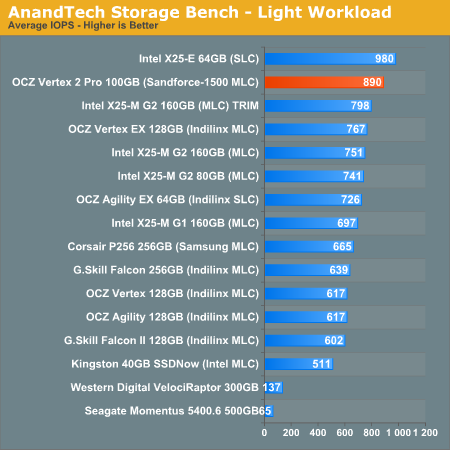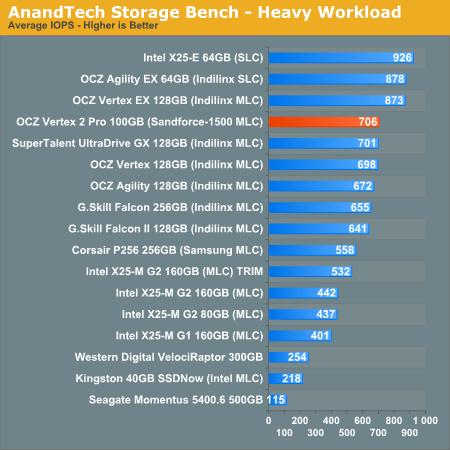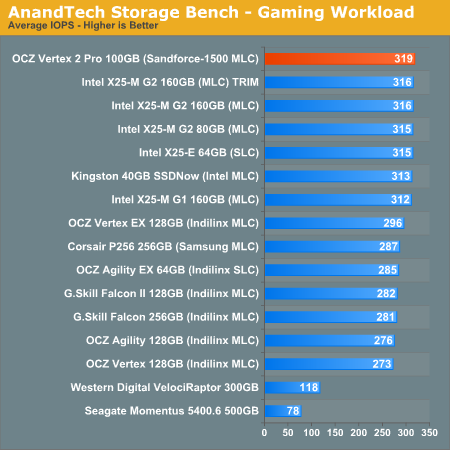OCZ's Vertex 2 Pro Preview: The Fastest MLC SSD We've Ever Tested
by Anand Lal Shimpi on December 31, 2009 12:00 AM EST- Posted in
- Storage
AnandTech Storage Bench
I introduced our storage suite in our last SSD article and it’s back, now with more data :)
Of the MLC SSDs represented here, there’s just nothing faster than the SandForce based OCZ Vertex 2 Pro.
Intel’s SLC based X25-E actually does very well, especially for a controller that’s as old as it is. It is worth noting however that the only thing separating Intel from SandForce-level performance is the X25-M’s low sequential write speed...
The first in our benchmark suite is a light usage case. The Windows 7 system is loaded with Firefox, Office 2007 and Adobe Reader among other applications. With Firefox we browse web pages like Facebook, AnandTech, Digg and other sites. Outlook is also running and we use it to check emails, create and send a message with a PDF attachment. Adobe Reader is used to view some PDFs. Excel 2007 is used to create a spreadsheet, graphs and save the document. The same goes for Word 2007. We open and step through a presentation in PowerPoint 2007 received as an email attachment before saving it to the desktop. Finally we watch a bit of a Firefly episode in Windows Media Player 11.
There’s some level of multitasking going on here but it’s not unreasonable by any means. Generally the application tasks proceed linearly, with the exception of things like web browsing which may happen in between one of the other tasks.
The recording is played back on all of our drives here today. Remember that we’re isolating disk performance, all we’re doing is playing back every single disk access that happened in that ~5 minute period of usage. The light workload is composed of 37,501 reads and 20,268 writes. Over 30% of the IOs are 4KB, 11% are 16KB, 22% are 32KB and approximately 13% are 64KB in size. Less than 30% of the operations are absolutely sequential in nature. Average queue depth is 6.09 IOs.
The performance results are reported in average I/O Operations per Second (IOPS):

If there’s a light usage case there’s bound to be a heavy one. In this test we have Microsoft Security Essentials running in the background with real time virus scanning enabled. We also perform a quick scan in the middle of the test. Firefox, Outlook, Excel, Word and Powerpoint are all used the same as they were in the light test. We add Photoshop CS4 to the mix, opening a bunch of 12MP images, editing them, then saving them as highly compressed JPGs for web publishing. Windows 7’s picture viewer is used to view a bunch of pictures on the hard drive. We use 7-zip to create and extract .7z archives. Downloading is also prominently featured in our heavy test; we download large files from the Internet during portions of the benchmark, as well as use uTorrent to grab a couple of torrents. Some of the applications in use are installed during the benchmark, Windows updates are also installed. Towards the end of the test we launch World of Warcraft, play for a few minutes, then delete the folder. This test also takes into account all of the disk accesses that happen while the OS is booting.
The benchmark is 22 minutes long and it consists of 128,895 read operations and 72,411 write operations. Roughly 44% of all IOs were sequential. Approximately 30% of all accesses were 4KB in size, 12% were 16KB in size, 14% were 32KB and 20% were 64KB. Average queue depth was 3.59.

Our final test focuses on actual gameplay in four 3D games: World of Warcraft, Batman: Arkham Asylum, FarCry 2 and Risen, in that order. The games are launched and played, altogether for a total of just under 30 minutes. The benchmark measures game load time, level load time, disk accesses from save games and normal data streaming during gameplay.
The gaming workload is made up of 75,206 read operations and only 4,592 write operations. Only 20% of the accesses are 4KB in size, nearly 40% are 64KB and 20% are 32KB. A whopping 69% of the IOs are sequential, meaning this is predominantly a sequential read benchmark. The average queue depth is 7.76 IOs.











100 Comments
View All Comments
vol7ron - Monday, January 4, 2010 - link
I don't think Anand has ever tried to predict market price. He generally lets us in on lot prices, that is, what retailers buy the merchandise for in quantities of 1000. Generally, when he does release that information, he is close to dead on. He typically does not way in on numeric estimates of market prices, other than statements like "they should be cheaper than...[insert product here]... because material/manufacturing costs are lower." The link you gave looks less to be a prediction and more to be what the suggested retail price is; much like buying a car, although the suggested price is printed, it does not mean the actual market price will be equal to it.As for the G1/G2, as you recall, the G2 was very low on initial release (at least at Newegg) to the tune of ~$225. There have been several factors that have driven this price up (~$300). This is due to demand, but really it is a step demand. They are on Revision 5 of the G2, but the important thing is the fact that the G2 has been recalled twice. Where demand is generally steady in terms of price, abnormal release dates have pushed demand higher at different points (the graph looks more like a staircase, hence "step"). The price will again fall in the future.
You should note that whenever things go "out of stock," the prices will go up, supply is low and demand is high, hence bargaining power from retailers, basic economics. Criticizing Anand does not accomplish anything as his facts were correct.
vol7ron - Monday, January 4, 2010 - link
Grammar/Syntax edit:"...lets us in on lot prices; that is, what retailers..."
"He typically does not [weigh] in"
Further note:
If you look at the Arrandale article, there is a price supply list. Those prices are for lots of 1Ku (1000 units), which reaffirms the point I made earlier, before I even looked at the Arrandale article.
As for Newegg, it's a unique site, which prices are close, but generally higher than the 1,000unit price. The fact that the G2 price was ~$225 on initial release was probably a promotional price point that often happens with new products.
viewwin - Monday, January 4, 2010 - link
Market forces are driving the price higher than MSRP(Manufacture Suggested Retail Price). Intel tried to have lower prices, but market demand pushed it higher. Prices were far lower on Newegg.com went the G2 first came out, but shot up to $600 at one point for the 160 GB. I recall an article about it, but can't find it.kunedog - Tuesday, January 5, 2010 - link
OK, so he's "out of touch" with actual market prices, instead of made-up retail prices (MSRP)."I recall an article about it, but can't find it."
That's OK, I saw the whole thing play out firsthand. After Anand posted these articles . . .
http://www.anandtech.com/storage/showdoc.aspx?i=36...">http://www.anandtech.com/storage/showdoc.aspx?i=36...
http://www.anandtech.com/storage/showdoc.aspx?i=36...">http://www.anandtech.com/storage/showdoc.aspx?i=36...
http://www.anandtech.com/storage/showdoc.aspx?i=36...">http://www.anandtech.com/storage/showdoc.aspx?i=36...
. . . stressing the expected performance and *affordability* of Intel X-25M G2 drives (I quote: "The performance improved, sometimes heartily, but the pricing was the real story."), they quickly disappeared from Newegg at the Anand-predicted price (with Newegg suggesting the G1s as an alternative, for which I call foul because many or most people wouldn't know the difference). They stayed out of stock for weeks. A month later, he posts this on the weekend:
http://www.anandtech.com/storage/showdoc.aspx?i=36...">http://www.anandtech.com/storage/showdoc.aspx?i=36...
The very next day (a Monday), G2s were suddenly in stock again at a huge markup, and the prices continued to climb for a few days. They've slowly fallen since that week, but never to the Anand-predicted price, and that fact has never been acknowledged in any of the subsequent reviews.
The pattern repeated with the Kingston 40GB drives:
http://www.anandtech.com/storage/showdoc.aspx?i=36...">http://www.anandtech.com/storage/showdoc.aspx?i=36...
The pricing prediction ($85 w/ rebate, $115 without) for it was apparently so important that it had to be right there in the summary (so you don't even have to click the full article to see it). I checked Newegg every day for a couple weeks after it was posted (and somewhat less often since) but *never* saw it in stock for less than $130 (which is the current price). Further, that article was repeatedly updated and bumped for minor and predictable updates (like new bugs/firmware), but the pricing of the Kingston never updated (even though the rebate is expired).
I would argue that market prices matter *more* than MSRP, and deserve Anand's attention. The high prices themselves aren't a problem; clearly people are willing to pay that much, therefore the drives are "worth it." It's Anand's complete obliviousness to them (after previously stressing their importance and total awesomeness) that comes across as strange.
chemist1 - Sunday, January 3, 2010 - link
Hi Anand,When you wrote: "Current roadmaps put the next generation of Intel SSDs out in Q4 2010, although Intel tells me it will be a 'mid-year' refresh," didn't you mean "*there* [not 'it'] will be a mid-year refresh?" I.e., that the next generation is still not expected out until Q4, but that there will be a mid-year updating of the current generation? [By writing "it" will be a mid-year refresh, you communicate that Intel told you that the next gen will be released mid-year instead of Q4, which is not what I think you meant to say .... or is it?]
vol7ron - Sunday, January 3, 2010 - link
Good question.To clarify what he's asking:
Is it a mid-year refresh and a 2010Q4 release?
-or-
Is the mid-year refresh going to take place instead of the Q4 release (Q4 is pushed back).
vol7ron - Saturday, January 2, 2010 - link
I thought GIGABYTE released a motherboard with SATA6 for AMD (GA-790FXTA-UD5). It might be nice to start testing it out and putting these SSDs to the test.Also, is it fair to take the enterprise level controller (SF-1500) and compare that to the consumer market product (X25-M)? Granted the SF-1500 has already stood well against the X25-E, but it's going to cost a heck of a lot more than the X25-M and the target market is the enterprise sector, anyhow.
Regardless of what it compares to, I'm already saying that the cost of this controller is overpriced. They can justify it however they would like; that is, better performance, high research and development costs, market barriers to entry, eg. The truth, though, is that they're overcharging. The logic is mostly sound, but the price is not. OCZ should sign a contract to buy the controller for a year, sell what they can, and negotiate a lower price, or else drop the controller. I'd like to see what that does to SF's profits.
I also would like to say that not using DRAM can have bad effects down the line. To get rid of it to justify a more expensive controller seems like an ignorant bargaining chip that SF is using to make more money. That's like saying, "I've upgraded your Ferrari with a newer, bigger engine, but it'll only take Regular [gas]." There's a high correlation between horsepower and Premium fuel; suffice to say the product might be faster, but it could be better.
vol7ron - Sunday, January 3, 2010 - link
Given time to think about this:Maybe it is fair to compare the SF-1500 to the X25-M, since they're both MLCs. However, if the SF-1500 is still supposed to be the enterprise version, the two products are not price equivalent.
Regardless, I do like to see the comparison. I just don't like to see the criticism when one is deemed an enterprise version and the other is still targeted for the home consumer/enthusiast.
Capt - Saturday, January 2, 2010 - link
...it would be nice to have a shootout between the test field (Vertex 2, X25-M, ...) and a pair some drives in a RAID0/Stripe configuration, especially comparing equal total sizes and different platforms (Intel/AMD chipset, hardware controllers). With the new about-to-be-released Intel RST drivers SSD stripe performance got boosted quite a bit, and although I guess there won't be much of an improvement in the 4k area, reading/writing larger blocks and sequential does improve by a massive amount. As a pair of two 80GB X25-Ms costs only 10% more than a single 160GB drive this scenario is very tempting...vol7ron - Saturday, January 2, 2010 - link
I also have been trying to get the reviewers to show more SSD RAID configurations. Not just because the price difference is semi-negligent, but because SSDs are suppose to be more error-free, and thus a more suitable technology for RAID. After all, isn't the exponential error potential the reason why RAID-0 was frowned upon?On the downside, I think there have been problems recently with the Intel Matrix Storage Manager, which might be one reason why the topic has been delayed. Regardless, it would be nice if this topic was re-addressed, if only to remind us readers that it is still in your thoughts :)